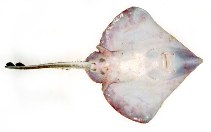| Family: |
Rajidae (Skates) |
| Max. size: |
125 cm TL (male/unsexed); max.weight: 11 kg |
| Environment: |
bathydemersal; marine; depth range 150 - 2117 m |
| Distribution: |
North Atlantic Ocean and adjacent fringes of the Arctic Region. Reported from the western Atlantic on eastern Grand Banks and Flemish Cap (about 46°N), a few records on the slope off Strait of Belle Isle to Davis Strait; probably continuous along the slope off Labrador; restricted in southwestern part of Greenland; eastern Atlantic off to most of Iceland to Faroe Islands, possible occurrence in western Irminger Sea and south to northern Rockall Trough; common in the Norwegian Deep and Skagerrak and northward along the Norwegian coast and shelf; periodic records in the southwestern Barents Sea. |
| Diagnosis: |
Dorsal spines (total): 0-0; Anal spines: 0-0; Anal soft rays: 0-0. Snout moderately long, its tip pointed and somewhat protruding; upper surface predominantly smooth, only on head and front margins more or less prickly, tail entirely spinulose, underside smooth; up to 4 thorns in front of as well as behind eye, a continuous median row of 42-51 thorns from nape to first dorsal fin (Ref. 3167). Upper surface plain fawn color, slate grey or clay grey, lower surface white, with a grey longitudinal band along tail and grey blotch on either side of cloaca (Ref. 6902). |
| Biology: |
Occur in moderately deep water but mainly around 250 m in boreal and partly arctic latitudes (Ref. 3167). Maximum reported depth at 2,117 m (Ref. 117245). Benthic (Ref. 58426). Feed on all kinds of bottom animals (Ref. 3167), invertebrates and fishes (Ref. 114953). Males mature at ca. 90 cm TL and young hatch at ca. 15 cm TL (Ref. 119696). Oviparous. Distinct pairing with embrace. Young may tend to follow large objects, such as their mother (Ref. 205). Eggs are oblong capsules with stiff pointed horns at the corners deposited in sandy or muddy flats (Ref. 205). Egg capsules are 10.7 cm long and 7.7 cm wide (Ref. 41251, 41301). It is not commercially important, and is possibly taken at low level by-catch in deep-water longline and trawl fisheries (Ref. 117245). |
| IUCN Red List Status: |
Least Concern (LC); Date assessed: 20 June 2019 Ref. (130435)
|
| Threat to humans: |
harmless |
| Country info: |
|
Source and more info: www.fishbase.org. For personal, classroom, and other internal use only. Not for publication.

